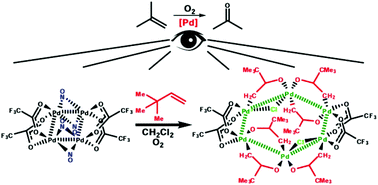Palladium ketonyl carboxylate complexes – potential models of polynuclear intermediates in olefin oxidation: formation and X-ray structure of Pd6(μ-Cl)2+x(μ-CF3CO2)4(μ,κ2-CH2C(O)CMe3)6−x (x = 0, 2)†
Abstract
Reactions of Pd4(NO)4(CF3CO2)4 with

* Corresponding authors
a
Leninsky pr., 31, Moscow, Russia
E-mail:
oshishilov@gmail.com
Fax: +007 495 9541279
Tel: +007 495 9554844
Reactions of Pd4(NO)4(CF3CO2)4 with

 Please wait while we load your content...
Something went wrong. Try again?
Please wait while we load your content...
Something went wrong. Try again?
O. N. Shishilov, R. E. Podobedov, Y. N. Rezinkova, A. V. Churakov and I. A. Efimenko, Dalton Trans., 2013, 42, 1338 DOI: 10.1039/C2DT31824E
To request permission to reproduce material from this article, please go to the Copyright Clearance Center request page.
If you are an author contributing to an RSC publication, you do not need to request permission provided correct acknowledgement is given.
If you are the author of this article, you do not need to request permission to reproduce figures and diagrams provided correct acknowledgement is given. If you want to reproduce the whole article in a third-party publication (excluding your thesis/dissertation for which permission is not required) please go to the Copyright Clearance Center request page.
Read more about how to correctly acknowledge RSC content.
 Fetching data from CrossRef.
Fetching data from CrossRef.
This may take some time to load.
Loading related content
